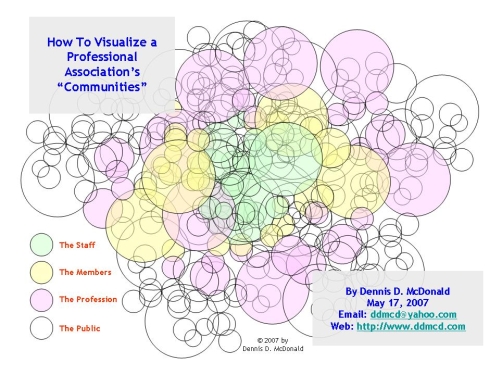This is my first attempt to visualize how the different “communities” interact in an organization such as a professional membership association:
The Staff. The green circles represent the different “communities” that staff members belong to, many of which are overlapping. The staff members in a large association belong to many different departments, they perform many different functions, and they manage many different projects. These result in the formation of a variety of permanent and temporary groups, some of which parallel the formal organizational structure of the association, and some of which are informal.
The Association’s Members. Member communities are represented here by yellow circles. The association’s staff serve the interests of the association’s members. The members also belong to many different overlapping and non-overlapping communities. Some of these members (and their communities) come into direct contact with staff members of the association; others do not. All are tied together through the common identification with the Association and the professional interests it represents.
The Profession. The pink circles represent the different communities that make up the profession that the association serves. Not all the profession’s communities or groups — formal or informal — are touched by the association’s membership. The degree to which this actually happens will vary from association to association and in some cases there will be professions with overlapping and “competing” associations.
The Public. The clear circles represent the different groups and communities within which the association, its members, and its profession operates. Here too there is overlap since members of the above three groups operate within the context of other public and private groups and frequently sponsor activities, such as public education or political action, that result in direct interactions with individuals who are neither association nor profession members.
Limitations of the model. This model is two dimensional and static, plus it cannot represent all the complexities that a formal sociometric analysis or social network analysis model can support.
That’s OK. This is just an approximation of the relationship complexity that exists within any large organization that operates within different social or professional ecosystems.
Such complexity based on intertwined social and professional relationships has always existed; read about the Manhattan Project and you’ll see what I mean. Today, though, the growth speed and size of networks-within-networks such as those pictured above can far exceed anything we experienced in the pre-digital age.
This calls for a modified approach to association member services. Member preferences — and dissatisfactions — can spread like wildfire within digitally enmeshed communities such as those pictured above. The slow speed with which more traditional association boards and committees have operated in the past may therefore need to change.
I say may need to change. I am not convinced that both traditional and nontraditional association governance and communication structures cannot be operated in a complementary fashion. Just as modern communications and networking allows an association’s public affairs staff to marshal public support overnight in the face of legislation it decides is inappropriate, so too association management can learn to respond quickly and directly to problems or crises that arise within the association’s membership. And it can do so based on policies developed carefully and in a deliberative fashion.
Using the model. I think it helps to visualize the complexity of the modern communication networking challenge that association management and members services face. Were I helping a professional association to develop a strategy for how to use social media and social networking, I would at least attempt to draw an approximation of this model based on the unique realities of the association in question, using colors and sizes to reflect an approximation of the relative size and variety of the social and communication environment.
At a minimum, I would want to review the model with management to illustrate the basic relationships that exist among the different groups within the association. This would help identify and prioritize where potential applications of social networking and social media exist. Another area to examine would be the different recurring meetings, conference calls, broadcast messages, and repeated email attachments that are distributed. This review would help identify the groups where tools such as blogs, wikis, and shared bookmarks might be applied most efficiently.
- To see a list of other articles from this blog that relate to associations, click here.
- To send the author an email, click here.


